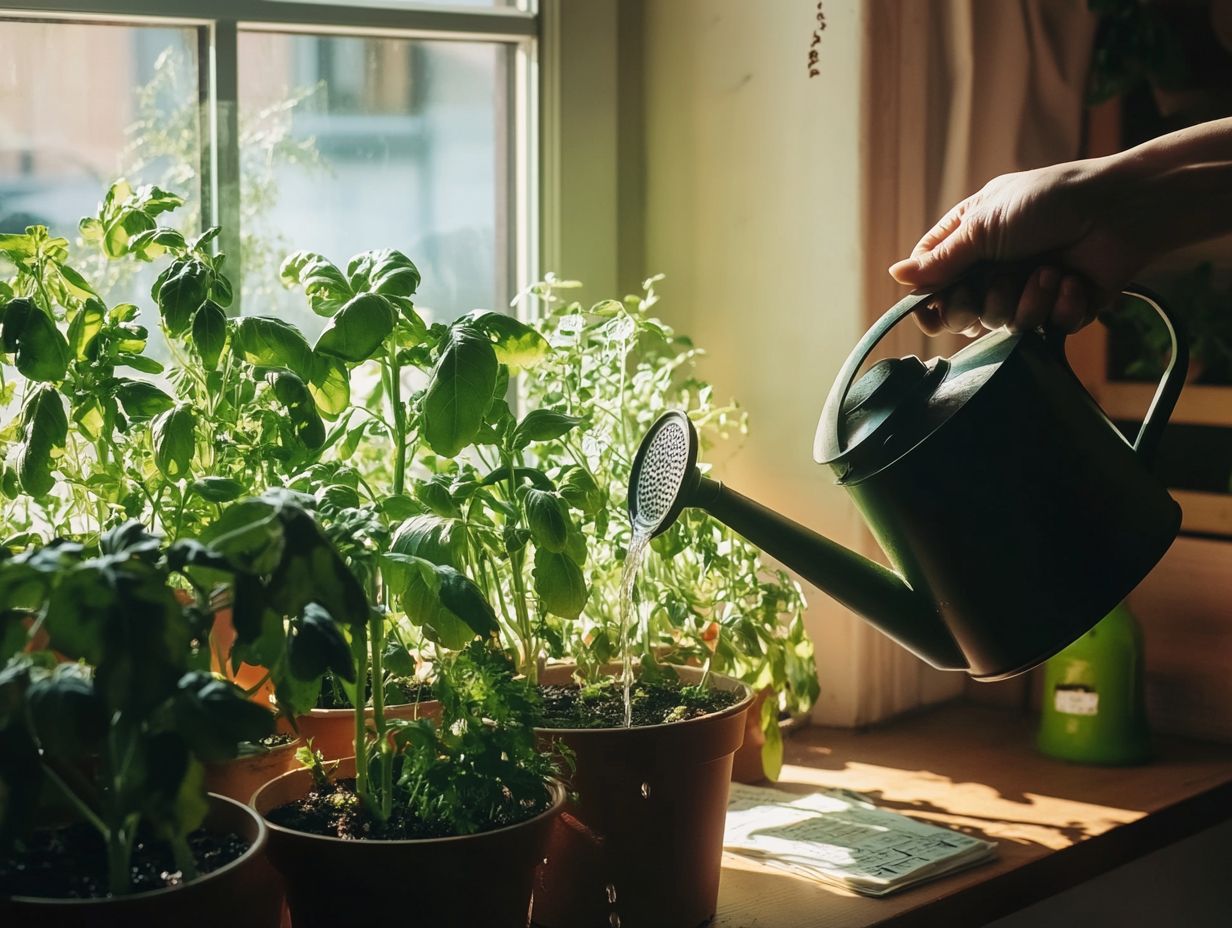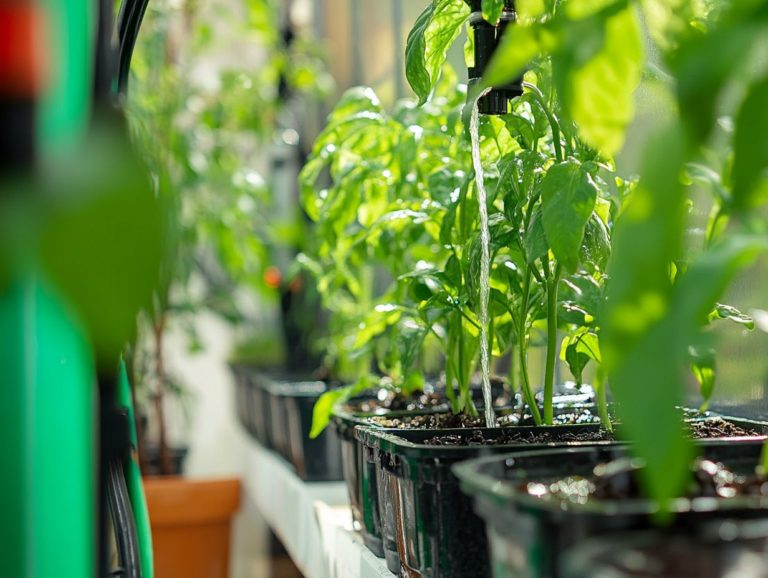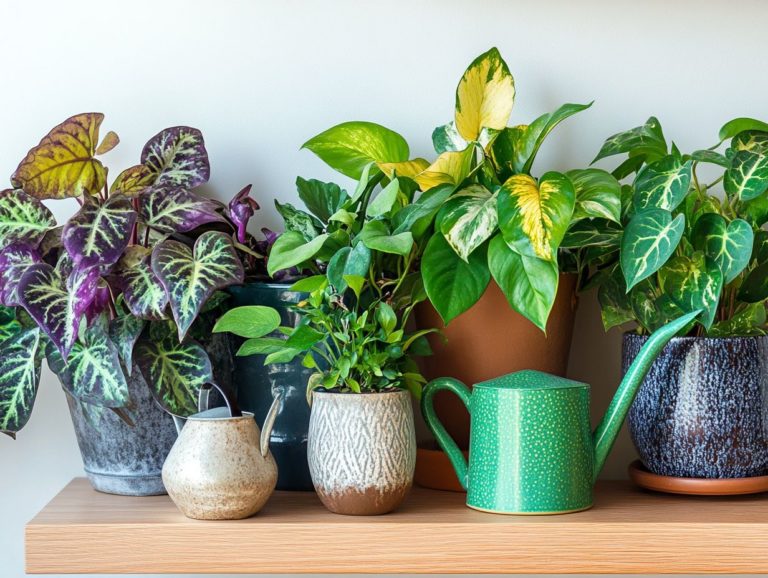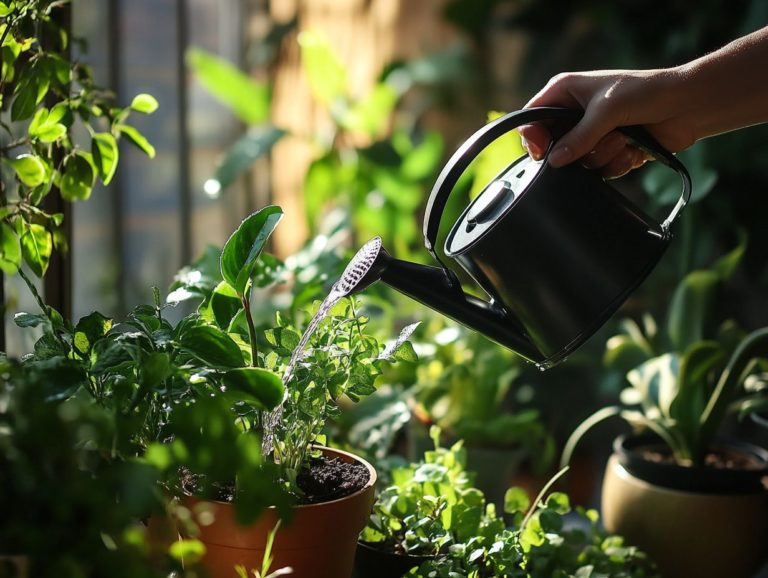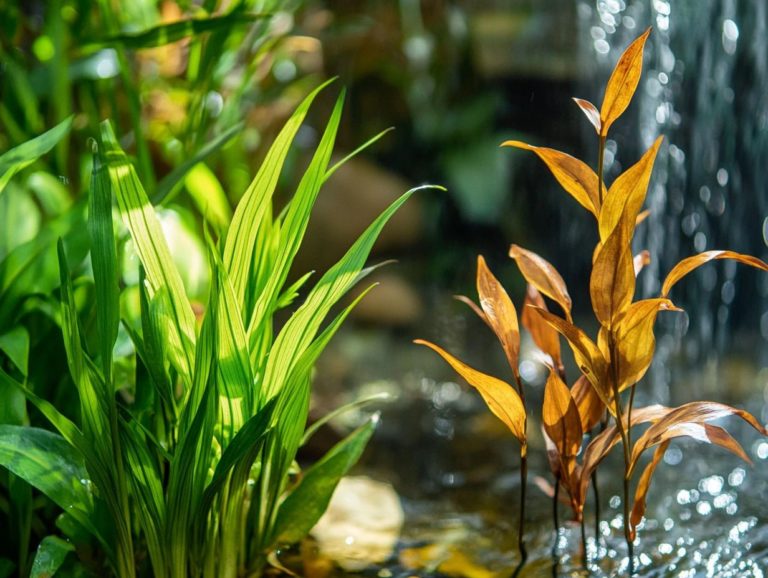Optimizing Watering for Indoor Vegetables
Growing indoor vegetables is a rewarding experience waiting for you! Mastering their watering needs is essential for ensuring thriving plants and a healthy harvest.
This article delves into the benefits of proper watering, examining the factors that influence your plants’ needs. It outlines the best practices to adopt for sustainable garden maintenance. You ll learn about the frequency and amount of water required, as well as how to identify the signs of overwatering or underwatering each crucial for your gardening success.
Additionally, you will discover tips to optimize water absorption and retention, ensuring your indoor garden flourishes beautifully and achieves healthy crops. Dive in and cultivate a healthier, more productive indoor vegetable garden!
Contents
- Key Takeaways:
- Benefits and Challenges
- Understanding Watering Needs for Indoor Vegetables
- Best Practices for Watering Indoor Vegetables
- Signs of Over and Underwatering
- Tips for Optimizing Watering
- Frequently Asked Questions
- What is the best way to optimize watering for indoor vegetables?
- How often should I water my indoor vegetables?
- Can I use tap water to water my indoor vegetables?
- 4. How much water should I give my indoor vegetables?
- 5. Can I water my indoor vegetables from the top or should I water from the bottom?
- 6. How can I tell if I am over-watering or under-watering my indoor vegetables?
Key Takeaways:

- Consistent, proper watering is essential for healthy indoor vegetables.
- Factors like plant type, environment, and container size affect watering needs.
- From frequency to method, knowing best practices can prevent common watering mistakes.
Benefits and Challenges
Creating a sustainable garden offers a wealth of benefits, from ensuring a bountiful harvest to enhancing plant health. It promotes efficient maintenance practices that greatly improve overall growth. Yet, this rewarding endeavor comes with its own set of challenges.
You will need to master proper watering techniques and understand soil moisture levels, which refers to the amount of water in the soil. You must also effectively manage plant diseases that may stem from inadequate care or environmental conditions.
Embracing these challenges will not only elevate your gardening skills but also lead you to a thriving, flourishing space.
Understanding Watering Needs for Indoor Vegetables
Understanding the watering requirements for your indoor vegetables is essential for fostering robust growth and optimizing yields. Pay close attention to factors like soil types and the unique water needs of young seedlings and established plants.
By meticulously monitoring these elements, you can avoid the pitfalls of overwatering and underwatering, which can induce stress in your plants and impede their development.
Factors Affecting Watering
Several factors influence the watering needs of your vegetable garden, including soil types, weather conditions, humidity levels, and the moisture retention capabilities of the soil. You can monitor these with a moisture meter to establish effective watering practices.
Local weather patterns play a crucial role in determining how often and how much water you should provide. For instance, on those hot, sunny days, evaporation rates soar, meaning you’ll need to water more frequently.
Seasonal changes also come into play; spring and summer typically demand more water than the cooler autumn months. The type of soil you have can significantly impact moisture retention sandy soils drain quickly and often require extra watering, while clay soils retain moisture longer but can risk waterlogging.
By considering these elements, you can tailor your watering strategies to promote optimal plant health and achieve a flourishing garden.
Best Practices for Watering Indoor Vegetables
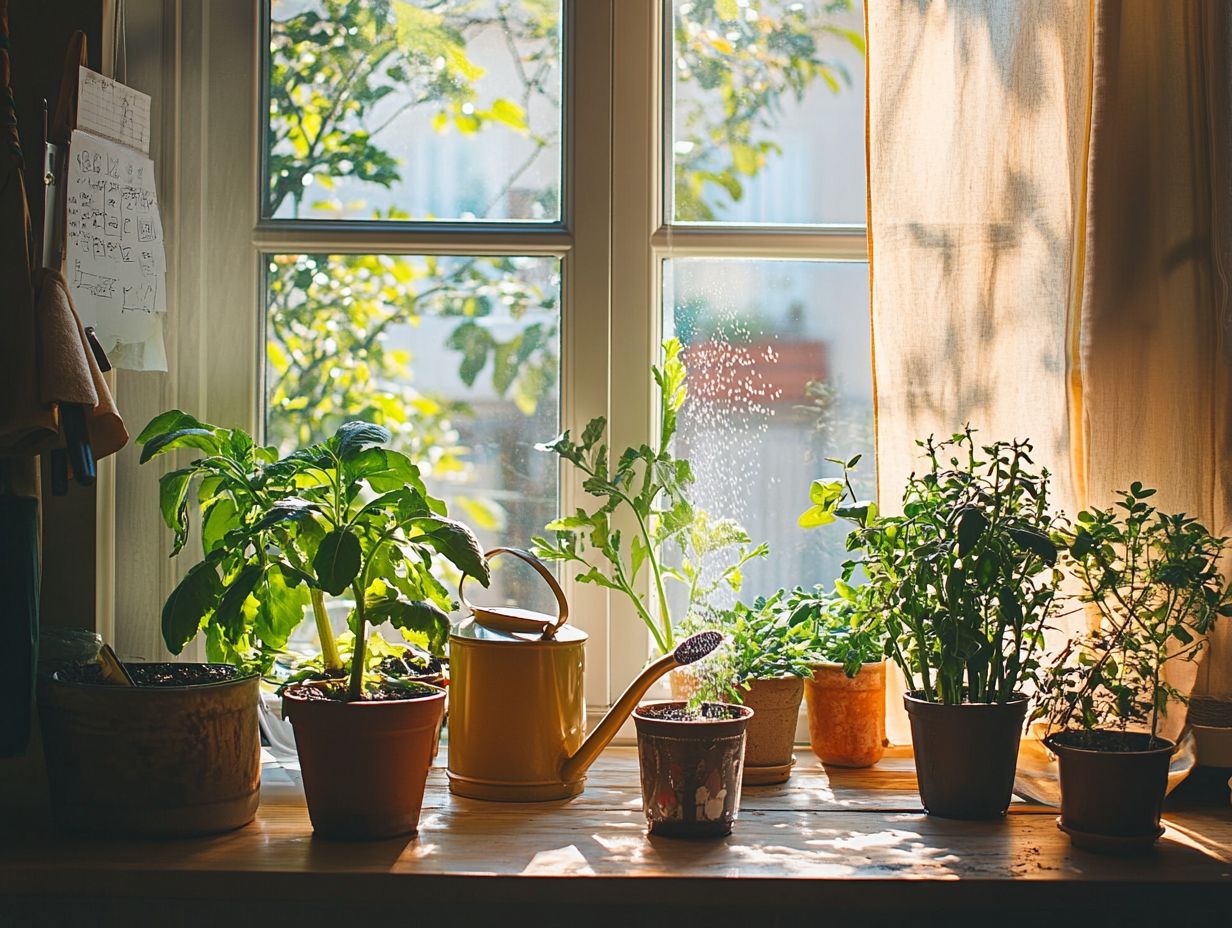
Implementing best practices for watering your indoor vegetables is crucial for fostering healthy plant growth and reaping a bountiful harvest.
By establishing a consistent watering schedule and utilizing techniques such as deep soaking, you can significantly enhance water efficiency. This can be achieved through effective watering systems to promote optimal plant health, especially in container gardening situations.
Start your watering journey today for a thriving indoor garden!
Frequency and Amount of Water
Determining the right frequency and amount of water for your indoor vegetables hinges on several factors, including the growth stage and specific needs of each plant. Young seedlings often crave more frequent watering to establish robust roots.
Established plants thrive on deeper, less frequent hydration to promote strong root development and healthy soil. Make it a habit to check the moisture levels in the soil, as different soil types hold water differently.
For instance, sandy soils drain quickly and may require more regular watering, whereas clay soils tend to retain moisture longer. By closely monitoring these elements, you can fine-tune your watering techniques.
Avoid common mistakes to ensure that each plant receives the perfect amount of water based on its growth stage. This thoughtful approach fosters optimal plant health while conserving water and preventing overwatering. To learn more about effective techniques, explore the science of watering indoor plants and act quickly to prevent root rot and other unwelcome problems!
Choosing the Right Watering Method
Selecting the right watering method is essential for providing your indoor vegetables with just the right amount of hydration. Options like drip irrigation and sprinklers offer distinct advantages.
Drip irrigation delivers water directly to the roots, minimizing evaporation losses and preventing unwanted runoff. This method not only conserves water but also encourages healthier root growth by maintaining consistent moisture levels.
On the other hand, overhead sprinklers cover larger areas, making them ideal for expansive vegetable gardens. However, they often lead to water wastage due to evaporation and uneven distribution.
Understanding each technique’s unique advantages enables you to make informed decisions that enhance both your plants’ health and sustainable water use.
Signs of Over and Underwatering
Recognizing the signs of overwatering and underwatering is crucial for ensuring optimal plant health in your vegetable garden. Symptoms of overwatering include yellowing leaves, root rot, and damping off in your young seedlings.
Underwatering shows up as wilting, browning leaf edges, and stunted growth in both young seedlings and established plants. Keep an eye out for these indicators to maintain a flourishing garden.
How to Spot and Fix Watering Problems
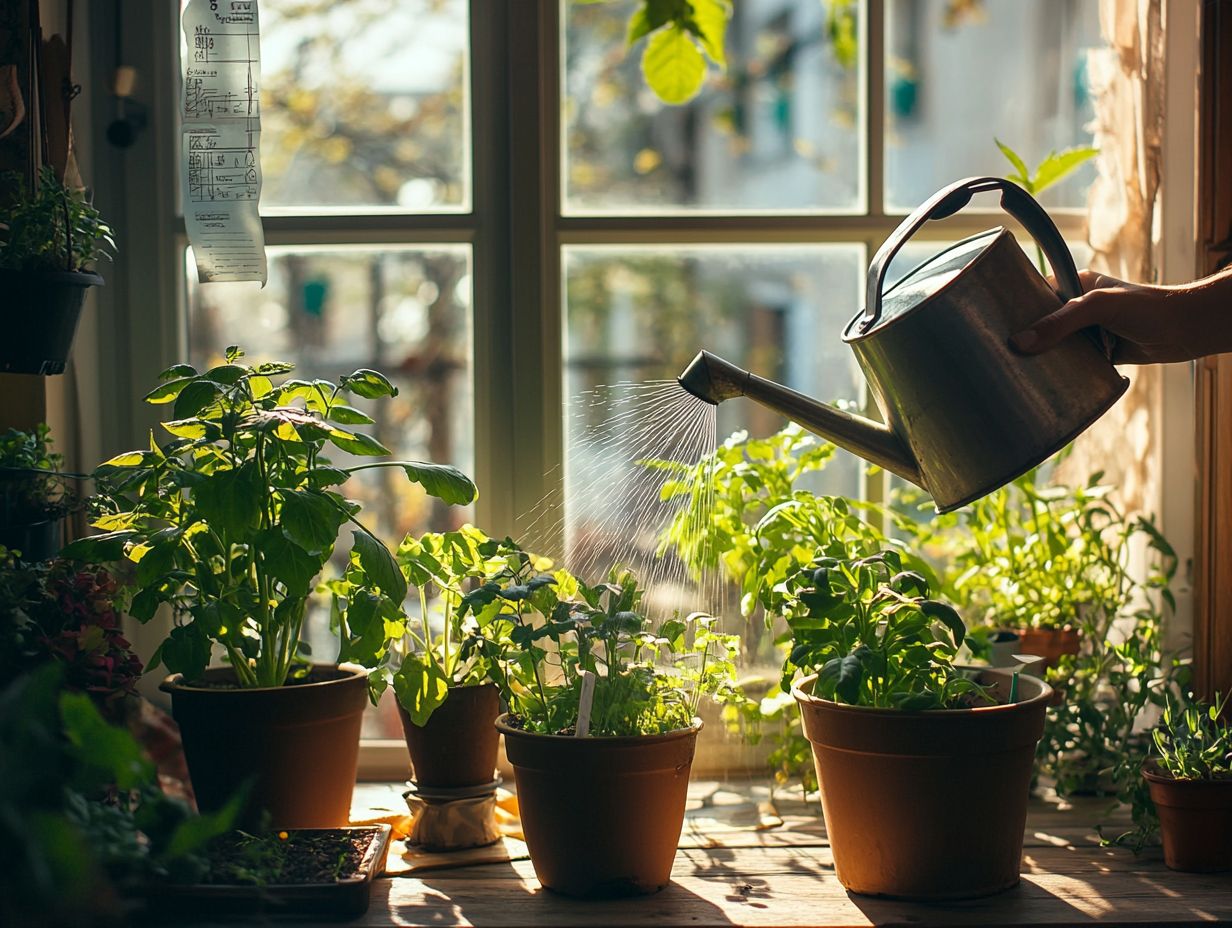
To maintain a flourishing vegetable garden, it’s essential to identify and tackle watering issues such as soil drainage and moisture fluctuations. Recognizing how water fluctuations can lead to plant diseases and affect soil moisture levels is crucial.
Regularly inspect your plants for signs of overwatering or underwatering, such as yellowing leaves or wilting. These symptoms often signal a specific disease or nutrient deficiency caused by inconsistent moisture.
Establish a watering schedule to easily adjust water amounts based on daily temperature and rainfall. Consider using a rain gauge for accuracy.
Incorporating mulch can help retain soil moisture and regulate temperature, creating a more stable growing environment. Keep an eye on soil drainage and aeration to promote healthy roots and maximize water absorption.
This ensures your plants absorb the right nutrients while reducing the likelihood of disease.
In conclusion, mastering proper watering techniques is vital for the health of your plants. Stay attentive, and your vegetable garden will thrive!
Tips for Optimizing Watering
Optimizing your watering practices is crucial for maximizing water efficiency and nurturing your indoor vegetables into thriving crops while ensuring sustainable gardening practices. By effectively utilizing watering systems like drip irrigation a system that delivers water directly to plant roots and sprinklers, along with handy tools such as moisture meters and a water gauge, you can effortlessly monitor soil moisture levels. Tailoring your watering strategies to perfection will save water and boost plant growth.
This approach conserves water and supports robust plant growth, especially when utilizing watering techniques for different indoor species, turning your gardening efforts into a flourishing success!
Maximizing Water Absorption and Retention
Maximizing water absorption and retention in your vegetable garden is essential for maintaining healthy soil and fostering optimal plant growth through the use of organic materials. Techniques such as incorporating compost and understanding humidity levels can significantly enhance your soil’s moisture-retention capabilities.
Ensure a consistent water supply for your plants by assessing the specific needs of your garden’s environment. For example, mixing in organic materials like leaf mold or well-aged manure can enhance soil structure and boost its capacity to hold water. Additionally, consider the best watering techniques for indoor plants to optimize your watering routine.
Selecting soil types that align with your local climate ensures that your plants’ roots can readily access essential nutrients and moisture. Understanding the influence of local humidity on your watering strategies enables effective planning, allowing your garden to flourish even during dry spells.
Frequently Asked Questions
-
What is the best way to optimize watering for indoor vegetables?
The best way to optimize watering for indoor vegetables is to first determine the specific watering needs of the vegetable type you are growing. This can be done through research or by consulting with a gardening expert. Then, monitor the soil moisture levels regularly and adjust your watering schedule accordingly.
-
How often should I water my indoor vegetables?
The frequency of watering your indoor vegetables will depend on factors such as the type of vegetable, the size of the container, and the humidity levels in your home. Generally, it is recommended to water every 1-2 days. However, always check the soil moisture level before watering to avoid over-watering.
-
Can I use tap water to water my indoor vegetables?
Yes, tap water is safe to use for watering indoor vegetables. However, if your tap water has a high mineral content or is treated with chlorine, consider using filtered or distilled water to prevent potential damage to your plants. Being environmentally responsible in your watering choices is important!
Start optimizing your watering today for a thriving indoor garden!
4. How much water should I give my indoor vegetables?
The amount of water your indoor vegetables need depends on their watering needs and the size of their container. A good rule is to water until you see liquid coming out of the drainage holes. This way, the entire root system gets enough water.
5. Can I water my indoor vegetables from the top or should I water from the bottom?
Water your indoor vegetables from the bottom. Place the container in a tray of water for a few minutes. This method helps water soak in from below, preventing leaf and stem damage. It also promotes deep root growth!
6. How can I tell if I am over-watering or under-watering my indoor vegetables?
Over-watering can cause yellow leaves and root issues, while under-watering leads to wilting and dry soil. Regularly check the soil moisture to adjust your watering schedule. Watch for signs of stress in your plants, and take action quickly to keep them healthy!

